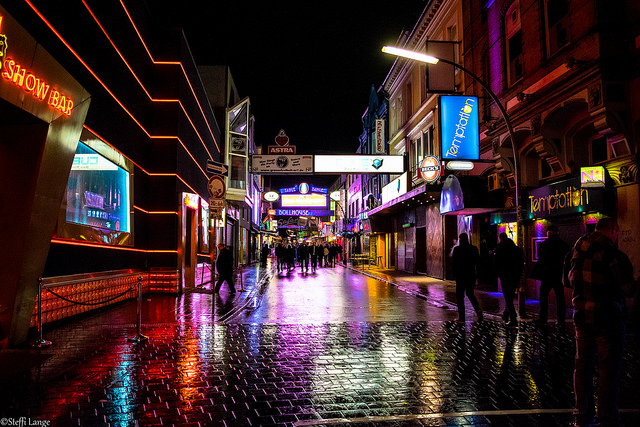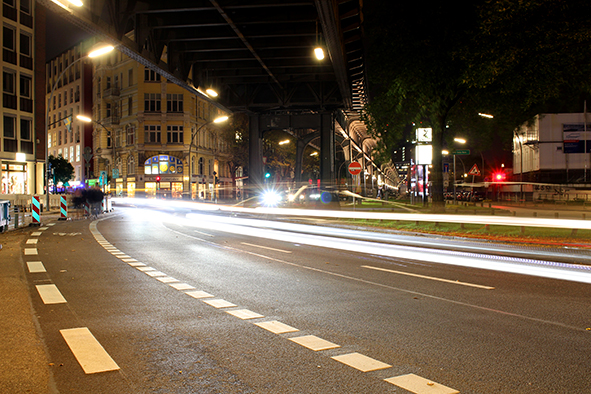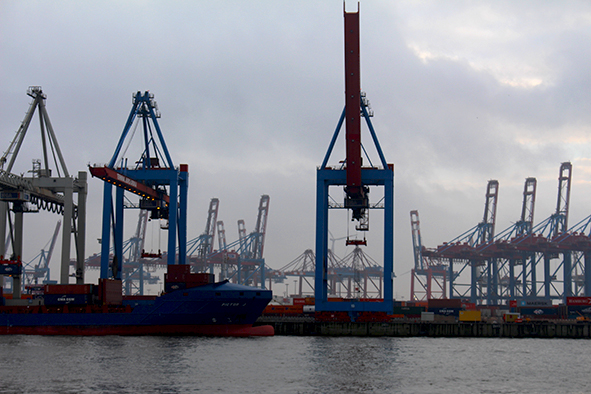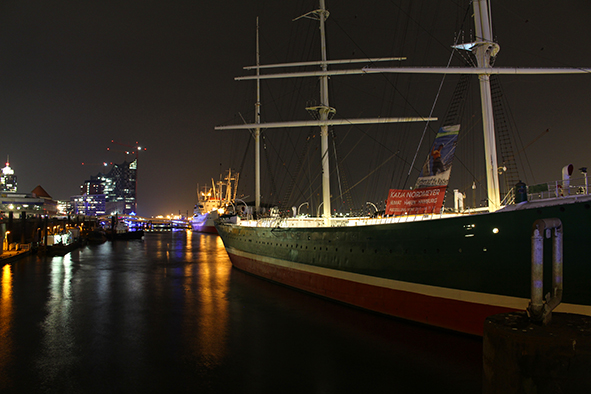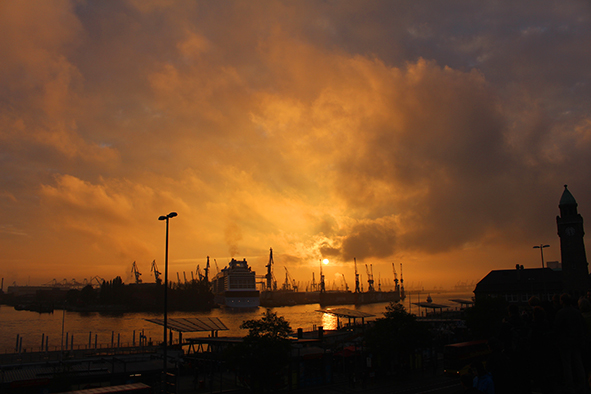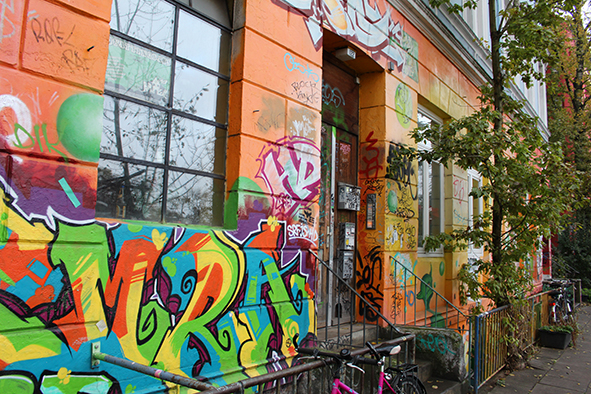With the Reeperbahn at its core, the St. Pauli district of Hamburg extends South to Hamburg Port and North to residential areas. The result is an area of distinct contrast.
Hamburg’s importance as a Port city is both St. Pauli’s blessing and its curse. The sailors who come in on the boats to the Port of Hamburg have always headed to St. Pauli for their recreational activities, and that in turn has buoyed both the entertainment and more lascivious industries there.
“Hey handsome, come here” said the young woman. She sounded Eastern European. Her bright red lipstick went beyond the contours of her lips in an attempt to make them appear more voluptuous.
“No thanks, I’m busy” I said averting my gaze, embarrassed.
She leapt from the doorway and grabbed my arm. Her grip was firm and I could feel the cold of her hands through the fabric of my shirt.
“How can you be too busy for me baby?”
“I’ve got, er, stuff…meetings or whatever” I said trying to free my arm.
My compadre Martijn gave her a curt reprimand in German and she released my arm.
“A bit forward, wasn’t she?” I asked as we pressed on through St. Pauli towards the infamous Reeperbahn.
“It is legal here so there is a lot of competition”. The legality of it had clearly done little to diminish the extent of the exploitation. If anything it seemed to merely condone it.
An Audible Legacy
We were in Hamburg’s St. Pauli district, only two blocks away from the busy Reeperbahn – a 1km stretch of bars and clubs that is fast becoming one of the trendiest nights out in Europe. It was still day time. St. Pauli is a district of contrasts, especially around its most famous street. By day the Reeperbahn is a bustling street and major thoroughfare, but with night comes neon and music and that was the reason I had come.
The Beatles famously resided and played along the Reeperbahn; it has also been immortalized in songs by Tom Waits, The Police, Elvis Costello and Van Morrison. Many great musicians have performed there including Jimi Hendrix, Little Richard and Ray Charles. Famed for its tremulous vicissitudes of flesh and narcotics, the street is a far cry from the place it was. If anything it has actually cleaned up a lot, being favoured more by trendy young people than the former denizens of the night.
We started the night to the North of St. Pauli on Schulterblatt Street, which for the most part was lined with crammed bars that spilled out onto the pavement. It was here, around one large derelict building – that looked as though it could have been a town hall at one point – where revelers and squatters mingled. The contrast was bizarre. Men with low-riding skinny jeans smoking roll-ups, and women in designer tops and high heels were interspersed with sullen immigrants in filthy, often torn clothing, who sat around the front of the building. One or two passed through a crack in a large sheet of plywood, which was proving a ineffective method of preventing access to the run-down building. A number of weathered banners suspended over the façade of the building begged mercy and justice for various people. I wondered what the squatters thought of the people who descend on the area every night to enjoy themselves. Noisy neighbours indeed.
By eleven the Reeperbahn was just filling up. Most clubs were already raucous and we opted for live music at headCrash. Getting anywhere near the bar or stage seemed improbable, and the band had decided to use the stadium volume settings on their PA system so it was more a cacophony than music. I wondered if the band were staging some sort of noise protest at being underpaid, the same way The Beatles had tried to break the rickety stage one night over five decades ago.
We found a pocket of air and inhabited that as the band ripped into either or a song or a contest of who could play their instrument the loudest. Off to my right a couple were making out on a divan, looking more like two hyenas fighting for food, oblivious to others who were attempting to avoid falling on top of them.
Back on the street hours later, ears ringing, people were trickling out of a range of establishments from fancy cocktail bars to table dancing emporia. Years ago the main Reeperbahn drag would have been an unnerving place late at night, but we happily mingled and chatted outside a fast food joint. One guy in leather pants bought a bag of beers and started handing them around. An old man in a duster jacket with missing front teeth joined us and began telling a tale of the high seas to a young blonde girl in a tube top. We looked more like a group of castaways thrust together by fate rather than chance acquaintances.
The all-embracing tone of the Reeperbahn seemed to be accepting of all, and whilst that may not be the case elsewhere in the world, nor indeed in Hamburg, it was nice to see a snapshot of equality that most people strive towards but never quite reach. I wondered if it would have been the same come daylight. Without booze.
On the Waterfront
The next day I wandered to the waterfront. Hamburg Port is the second largest in Europe. Cranes cluster like herds of giraffes. A multi-storey cruise liner was being built. Sailboats and cargo ships, small skiffs and passenger ferries all plied the same strip of water.
A group of fellows on shore leave made for the red light zone. Upon the red gate blocking the view to that particular street, a small sign warning against the admission of minors and women was eclipsed by the slogan “Für mehr vorspiel” on a cigarette ad, meaning “For more foreplay”. One would hope that health consciousness also prevailed in the area as well. The men passed through the gates unabashed.
I took a seat in one of the cafes along St. Pauli docks and ordered copious amounts of fischbroetchen – fish and bread – particularly the delicacy Bismarck Herring. The passenger ferry plied a circular route of the port, so I decided to get a better look at what really makes Hamburg tick. Huge engineering ships bound for all corners of the earth were dropping off or picking up cargo.
Ships in various states of construction were illuminated by the blue fizz of a welding iron. Refurbished sailing boats that may have conveyed spices and silk at one time were now moored up ready to accept tourists and party groups in place of grizzled sea dogs and cargo. The scruffy buildings of St. Pauli gave way to newer buildings and eventually cottages and homes of the more affluent. I got off the boat and wandered back towards St. Pauli.
Throughout streets above the port, lined by buildings in disrepair, some of them also harbouring droves of squatters, crowds of people had gathered looking out towards the big cruise liner. A thin wisp of sooty smoke dribbled from its chimney. “What is everybody waiting for?” I asked one man. “We are all here to see the ship begin her maiden voyage” he said with anticipation, as though he were about to watch Germany play in the World Cup final. “She is the biggest boat ever constructed in Hamburg.”
There was little movement. It could have been hours before it was moved out of its dock towards the open sea. But as though the people had gathered for a grand spectacle, the sky turned a deep burnt orange by inches as the sun set. Night falling once again as the Reeperbahn opened its doors of temptation once more.
